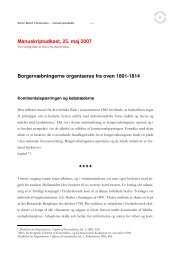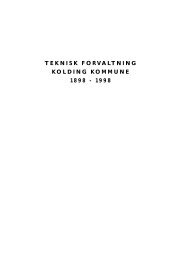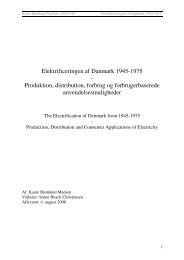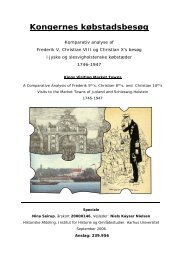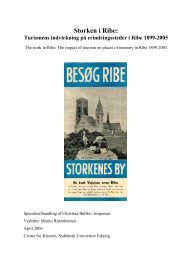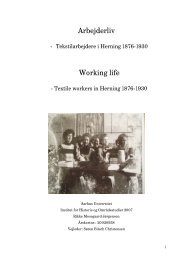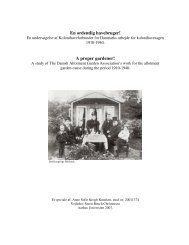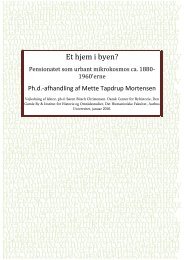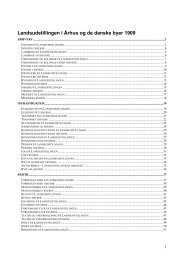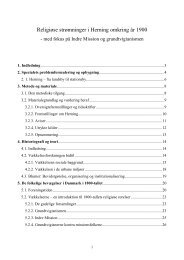Unscrewing the Creative City
Unscrewing the Creative City:
Unscrewing the Creative City:
- No tags were found...
Create successful ePaper yourself
Turn your PDF publications into a flip-book with our unique Google optimized e-Paper software.
<strong>Unscrewing</strong> <strong>the</strong> <strong>Creative</strong> <strong>City</strong>:<br />
The Historical Fabrication of Cities as Agents of Economic Innovation<br />
and Creativity<br />
Contact: ilja.vandamme@ua.ac.be<br />
Centre for Urban History (University of Antwerp)<br />
Organizers: Ilja Van Damme, Bruno Blondé and Andrew Miles<br />
University of Antwerp – University of Manchester<br />
Call for Chapters: If <strong>the</strong> following mission statement appeals to you and if you would like to participate in <strong>the</strong><br />
ensuing book project, please forward abstracts (max. 400 words) to <strong>the</strong> above address before <strong>the</strong> 1 May 2013.<br />
Selected papers will be presented as preliminary chapters at a conference to be held in Antwerp (Belgium) in<br />
December 2013. Publication of <strong>the</strong> book is planned for 2014.<br />
Mission statement: In <strong>the</strong> past decade, much has been said and written about why cities are creative. The<br />
torrent of publicity surrounding <strong>the</strong> much-discussed books by Allen J. Scott, Richard Florida, and o<strong>the</strong>r<br />
authors caused such concepts as <strong>the</strong> ‘creative’ or ‘cultural economy’, ‘<strong>the</strong> creative class’ or <strong>the</strong> ‘creative<br />
city’ to spill over into <strong>the</strong> academic discourse of sociologists, economists and human geographers<br />
discussing economic innovation and creativity. As cleverly noted by Martina Hessler and Clemens<br />
Zimmerman in one of <strong>the</strong> few historical books devoted to <strong>the</strong> subject, however, much of <strong>the</strong> ongoing<br />
debate has consisted of ‘conspicuous euphoria, hysteria and affirmation’ by policymakers and creative<br />
thinkers alike, all fuelling <strong>the</strong> belief ‘that creative industries, <strong>the</strong> creative class and culture will be <strong>the</strong><br />
engine of <strong>the</strong> economy, and that cities will be both <strong>the</strong> condition of this development and its beneficiary’. 1<br />
Studies on <strong>the</strong> creative city thus tend to blur <strong>the</strong> distinction between that which is to be explained (how<br />
and why creativity becomes clustered in cities) and that which can explain <strong>the</strong> process of economic<br />
innovation and creativity (<strong>the</strong> ‘agency’ of <strong>the</strong> city). The city appears as some sort of force of nature – a kind<br />
of ‘natural’ breeding ground for ‘life cycles’ of economic invention and creativity.<br />
1 M. Hessler and C. Zimmermann eds., <strong>Creative</strong> urban milieus. Historical perspectives on culture, economy, and <strong>the</strong> city<br />
(Frankfurt and New York 2008) 12 and 20.
In The economy of cities (1969), Jane Jacobs (<strong>the</strong> ‘grandmo<strong>the</strong>r’ of <strong>the</strong> current ‘creative city’ debate)<br />
assumes that <strong>the</strong> natural endowments of cities – <strong>the</strong> typically dense, close living arrangements within a<br />
heterogeneous population and <strong>the</strong> resulting interactions – created a specific kind of ‘milieu’ in which<br />
innovation and creativity was bound to flourish. Historians have also had few reservations about<br />
automatically equating cities with places of economic progress, creativity and modernisation. For example,<br />
in Cities in Civilization (1998), Peter Hall considers creativity and innovation as a sort of generic<br />
determinant of global urban culture itself, ready to be tapped as soon as certain conditions (e.g. size,<br />
prosperity, schooling and communicative networks) are in place. This project aims to break away from such<br />
unquestioning, abstract or intuitive use of <strong>the</strong> city as an explanatory agent in research on <strong>the</strong> creative<br />
economy. Our goal is to open <strong>the</strong> ‘black boxes’ on which <strong>the</strong> notion of <strong>the</strong> creative city rests.<br />
With <strong>the</strong> help of <strong>the</strong> metaphor of black boxes, Bruno Latour and o<strong>the</strong>rs notoriously refer to scientific (or<br />
o<strong>the</strong>r) modes of thoughts, habits, forces and objects that ‘no longer [need] to be reconsidered, those<br />
things whose contents have become a matter of indifference’. 2 In this vein, we will systematically question<br />
and historicise <strong>the</strong> ideas (e.g. freedom, tolerance, diversity), actors (e.g. entrepreneurs, artists, inventors,<br />
scientists, bohemians, gays), institutions (museums, academies, universities) and inanimate physical<br />
‘actants’ (e.g. art, commodities, machinery) that make us intuitively associate cities with creativity and<br />
innovation. Ra<strong>the</strong>r than seeing <strong>the</strong>se ideas, actors, institutions and materials as signs of <strong>the</strong> creative and<br />
innovative potential of cities, we will focus on <strong>the</strong> physical practices, discourses and related power<br />
struggles and conflicts that have resulted in <strong>the</strong> belief and, ultimately (perhaps), <strong>the</strong> reality that certain<br />
cities have been breeding grounds for creativity and economic innovation.<br />
Specifically, contributors should relate to <strong>the</strong> following research questions:<br />
- How has economic creativity and innovation been made and unmade in speech acts and performative<br />
processes situated in space and time, and driven by <strong>the</strong> discerning agency of animate actors and inanimate<br />
‘actants’?<br />
- How did <strong>the</strong> creative city become <strong>the</strong> relational, ‘networked’ product of <strong>the</strong>se historically altering ‘urban<br />
assemblages’?<br />
2 M. Callon and B. Latour, ‘<strong>Unscrewing</strong> <strong>the</strong> big Leviathan: how actors macro-structure reality and how sociologists help <strong>the</strong>m to do<br />
so’, in: K. Knorr-Cetina and A.V. Cicourel eds., Advances in social <strong>the</strong>ory and methodology. Toward and integration of micro- and<br />
macro-sociologies (Boston 1981) 285.
Applicants are challenged to rethink <strong>the</strong>ir own research on <strong>the</strong> creative city by looking at creativity and<br />
economic innovation as not solely constituting ‘objective’ activities taking place within <strong>the</strong> urban fabric, nor<br />
as something that is merely a ‘brand’, ‘identity’ or a constructed representation. In our book, <strong>the</strong> ‘creative<br />
city’ becomes conceptualised as an emerging and unstable material and symbolic achievement (or<br />
‘assemblage’) of concrete historical processes governed by ideas, physical actions and materials. 3 As such,<br />
contributors are encouraged to make critical use of approaches associated with Actor-Network Theory<br />
(ANT) or to reflect on <strong>the</strong> meaningfulness of such approaches for <strong>the</strong>ir own lines of research on <strong>the</strong><br />
creative city.<br />
Contributions: With regard to <strong>the</strong> type of contributions, our focus is predominantly on European case<br />
studies from <strong>the</strong> sixteenth through <strong>the</strong> twentieth centuries. We also welcome historiographic and<br />
conceptual papers, including works by non-European experts. Although this ‘call for chapters’ was written<br />
by historians, and although it encourages an innovative grasp on <strong>the</strong> ‘creative city’ throughout history,<br />
interdisciplinary perspectives are welcomed.<br />
Background: This book is <strong>the</strong> first volume in a series devoted to <strong>the</strong> subject of ‘urban agency’, <strong>the</strong> aim of which is to<br />
produce a new, multi-authored history of modern Europe in four volumes, reflecting <strong>the</strong> current state of research in<br />
<strong>the</strong> field. Organised by two major centres of Urban History, Antwerp and Leicester, <strong>the</strong> series will represent current<br />
cutting-edge research on Europe’s urban inheritance, and it will help to define <strong>the</strong> parameters of debate for <strong>the</strong> next<br />
generation of research. To this end, <strong>the</strong> general editors, Bert de Munck and Simon Gunn, have written a paper<br />
setting out <strong>the</strong> rationale for <strong>the</strong> project, as well as <strong>the</strong> principal ideas behind it. This platform text can be obtained<br />
from Bert De Munck (bert.demunck@ua.ac.be). In practical terms, <strong>the</strong> project has emerged from <strong>the</strong> international<br />
research community ‘Urban Agency: Setting <strong>the</strong> Research Agenda of Urban History’, funded by <strong>the</strong> Scientific<br />
Research Council, Flanders (FWO-Vlaanderen) and initiated by <strong>the</strong> Centre for Urban History in Antwerp.<br />
3 For a similar approach to <strong>the</strong> city, read I. Farias and T. Bender eds., Urban assemblages. How actor-network <strong>the</strong>ory changes<br />
urban studies (Londen and New York 2011).





